The Samsung Galaxy Note7 (S820) Review
by Joshua Ho on August 16, 2016 9:00 AM ESTSystem Performance Cont'd
Now that we've covered more general purpose benchmarks that tend to emphasize CPU performance and GPU compute performance, we can look at benchmarks that tend to more strongly emphasize things that games will see benefits from such as improved GPU graphics performance and improved CPU physics processing performance.
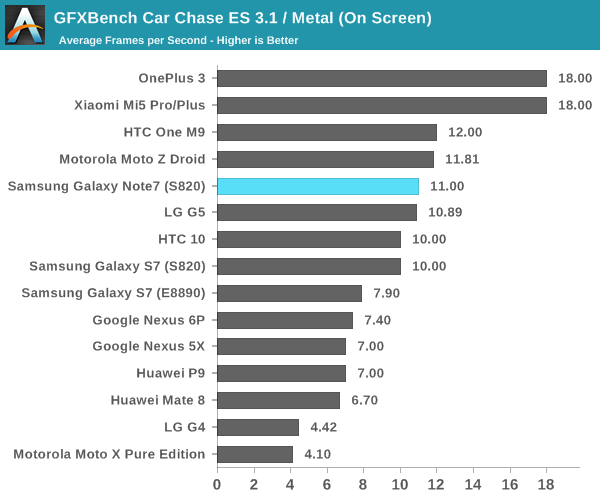
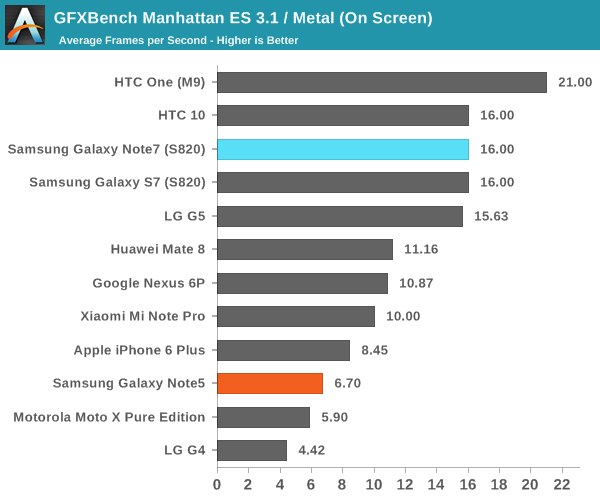
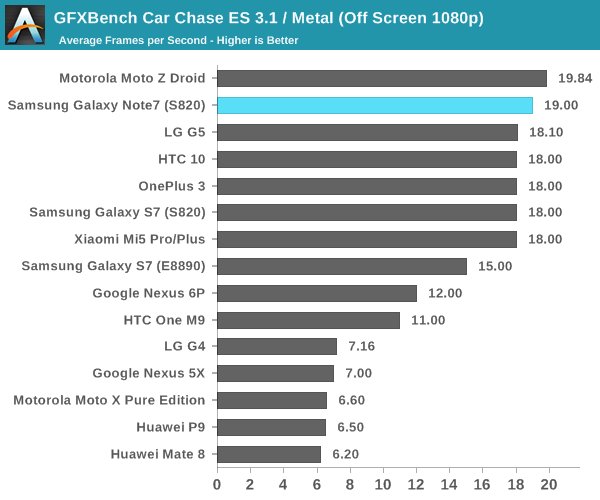
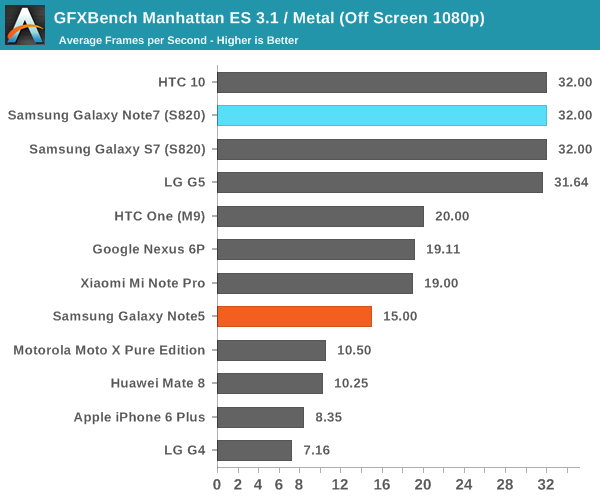

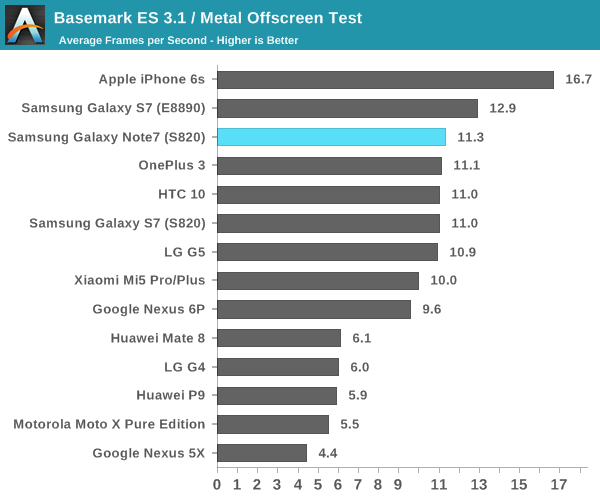
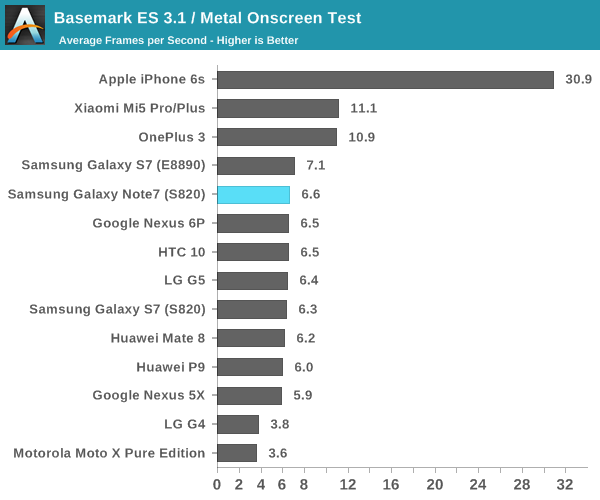
It's probably no surprise, but the Galaxy Note7 performs as expected with the latest drivers and in ideal thermal conditions. The Adreno 530 should be more than sufficient for the forseeable future but for maximum performance it's best to enable 1080p rendering or lower to maximize frame rates in games like Real Racing 3 that tend to really use the GPU to its fullest extent.
NAND Performance
Of course, while Discomark provides a sort of holistic view of performance for a specific task, it’s also important to at least try and break down the various aspects that impact system performance so rather than simple black box testing we can further understand what factors influence performance and therefore provide additional information to make better buying decisions. One of the major contributors to general purpose performance is going to be storage performance, which is often something often ignored by marketing as the nitty gritty details of NAND storage realistically require some background in solid state physics and devices to understand, as well as some understanding of computer science and engineering.
While I’m not really happy with the state of our mobile storage benchmarks, for now I don’t really see another option here as the publicly available storage benchmarks for Android and iOS are fairly basic. Putting aside the state of the benchmarking industry, our current benchmark remains AndroBench 4 which provides at least some basic storage benchmarking capabilities. We use custom settings with this benchmark which attempts to make the test more realistic as the default settings are just wildly unrealistic. This includes adjusting the buffer size, increasing the file size to 100 MB, and only using one thread instead of 8. 256KB file size is targeted as this is the most common block size if you profile this kind of thing for sequential writes and reads, while 4KB block sizes are the most common for other tasks as the vast majority of computer architectures use 4KB pages for virtual memory. Single-threaded I/O is common in most cases because multi-threaded programming is still difficult for most people to reason about in an effective manner because conscious thought is inherently serial in nature with some multiplexing. In addition to this, many eMMC solutions on the market don’t really perform well with multiple threads simultaneously as the controller can’t do anything with extra requests other than reply with a busy signal which already happens with a single thread.
Putting aside discussions of testing we can take a look at the storage solution used in the Galaxy Note7 before getting into the actual results. The Note7 continues to use basically the same storage solution as the Galaxy S7 and S6, which is to say an MLC-based solution that has a UFS Gear 3 single lane interface for bandwidth up to 600 MB/s and basically has the exact same model number if you check the SCSI devices attached to the system save for some changes that indicate the higher 64GB storage relative to the 32GB chips that are most common in the Galaxy S7.
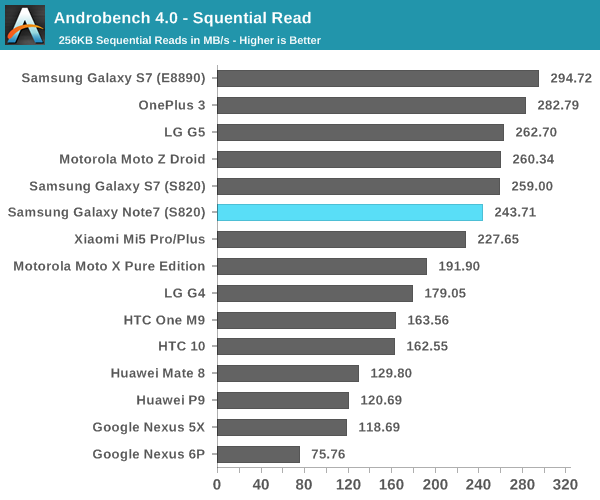

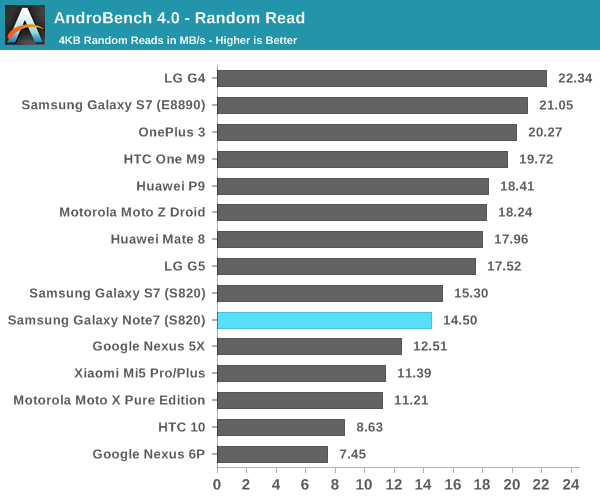
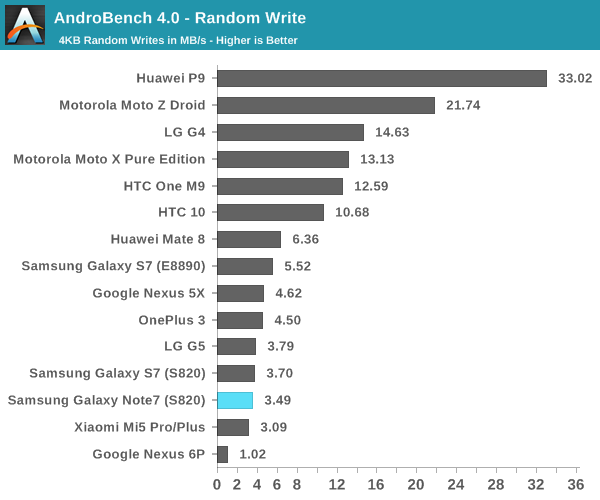
Looking at the test results it performs exactly as quickly as you’d expect from this MLC solution as we’ve tested it in the Galaxy S6, S6 edge, S6 edge+, Note5, S7, S7 edge, and now the Note7 as well as the LG G5. The performance here is acceptable but obviously if you look at burst performance the iPhone 6s has a faster solution due to the hybrid SLC/TLC storage solution. The main benefit of pure MLC NAND is that performance is more consistent as there’s no precipitous drop when the SLC buffer fills. There’s always room to improve but I don’t really see how it’s going to happen unless Samsung moves to V-NAND for the next generation.










202 Comments
View All Comments
HideOut - Tuesday, August 16, 2016 - link
"You also get an extra 32 GB of storage which does justify the extra 100 USD that bumps the Note7 up to 850 USD."You must work for apple if you somehow think that 32Gb of on board storage is worth $100. FFS its about 1/5 that to buy in any other format.
bJammin - Tuesday, August 16, 2016 - link
Sorry for a nitpick, but this isn't the first phone with an iris scanner, though probably the first with wide availability. Fujitsu's is only available in Japan right now, but I have one as my company phone. The phone and scanner are actually pretty slick too despite being based on older tech, though Fujitsu's interface is pretty awful.http://www.gsmarena.com/fujitsus_latest_phone_is_w...
Vagabondjonez - Tuesday, August 16, 2016 - link
Still no htc 10 review or a Twitter response....Lau_Tech - Tuesday, August 16, 2016 - link
Well done on the improvements in timeliness and tone, Josh. I certainly agree with other reader opinions that the S-Pen deserved a full page of its own, given that it continues to be a distinguishing factor from all other phones. I understand that it may feel unnecessary if its the same as last years models, but it is still worth a re-look and run through. After all, Samsung's screens have not changed much either, and you still ran them through a gamut of tests.I must say that your continued placement of Samsung's AMOLED's as being "one of the best" or equal to Iphones to be have long since been untenable. Samsung's AMOLED beats or equals the Iphones in every one of your metrics. Colour-shifting remains the sole issue, but is not on its own sufficient to deny Samsung's phones the title of "best display, period".
Lau_Tech - Tuesday, August 16, 2016 - link
I should also point out that your (justified) decision to be nit-picky about design must be applied fairly to your upcoming iphone 7 review as well.If you intend to highlight design issues that do not affect the user experience (as has been done in this review), I would expect that you find fault with the Iphone 7s IF the Iphone 7s maintain the unwieldy bezel sizes of the 6 plus, and the added inconvenience of the USB-only audio jack. These should count as negatives against the Iphone 7s.
Your criteria for commenting on design must be seen as fair.
JoshHo - Wednesday, August 17, 2016 - link
If there's a real demand for this sort of ID analysis I'll keep going with it.To outline some of my personal thoughts for design:
1. I don't see a ton of value to extremely thin bezels. Excessive bezel like the M8/M9 is one thing but the 6s Plus had no issues with ergonomics in use. I view phablets as phones that need two hands to be used but still fit in one pocket so I don't pay that much attention to bezel unless it's really egregious like the M8/M9.
2. The S-Pen would have received further analysis but battery life testing alone took up a full 3 days. It's been made clear to me that timeliness is critical so I would rather cut out discussion on things that are fairly well understood and revisit it in future short-form than cut out data that answers essential questions.
3. To me AMOLED's color shifting issues are fairly significant and power efficiency in high APL scenarios is still lagging slightly behind LCD. If power efficiency rises above LCD then I would say shipping LCD would automatically count as a negative against an OEM, but until that comes to pass I think it's important to weigh these things on a case by case basis.
4. If the iPhone 7 loses the 3.5mm jack it would require close examination and weighing of the advantages and disadvantages. I would trend towards likely being a bad idea but we'll have to see how it plays out. There are a lot of ways this could be executed and some are good but others are awful.
Lau_Tech - Wednesday, August 17, 2016 - link
Thanks for the detailed reply Josh, I appreciate the time taken.Im definitely with you with regards to points 2 and 4. I think with regards to points 1 and 3 we will have to agree to disagree.
I look forward to the HTC 10 review, of which I am already an owner. I'm sure you'll be able to point out interesting things about this device (some nuggets already present in this review)
jlabelle2 - Friday, August 19, 2016 - link
I am also quite shocked about the change on editorial note (because it seems really to be that) since Anand departure. Even with Anand working for Apple, reviews were still much more factual.I have an iPhone 6S but honestly, there is not denying that the S7 Edge and Note 7 are just a marvel of design.
Also, saying that bezels do not matter is NOT a matter of opinion. We are speaking of phablet here and the very reason why not everyone have 6" phones is the size of those phones. So when the Note 7 include a 5,7" screen in a form factor which is 5mm shorter and 4mm narrower than a 5,5" iPhone 6+, this is huge achievement and has a significant competitive advantage compare to the iPhone or other bulkier large phone.
At last, how can anyone still defend LCD against Samsung OLED screen implementation? The argument that there would be color shifting when looking the phone from the side (which obviously no one is doing) shows the extent of bad faith.
Again, as an iPhone (and Windows phone user), and having no Android, I am puzzled by such review and what kind of goal is tried to be achieved...
NitT - Tuesday, August 16, 2016 - link
I feel like I am a minority here as I am OK with Touchwiz. I do not feel any lagging. On the other hand, when I use other Android phones such as HTC or Vivo, I feel that I miss so many settings. My latest HTC phone was HTC M7/M8. It is quite sad as I could not find newer HTC flagship models in my country.WoodyPWX - Wednesday, August 17, 2016 - link
Finally someone who isn't afraid to say something bad about Note 7. Every other reviews are practically without any real criticism. Thanks for a honest review!